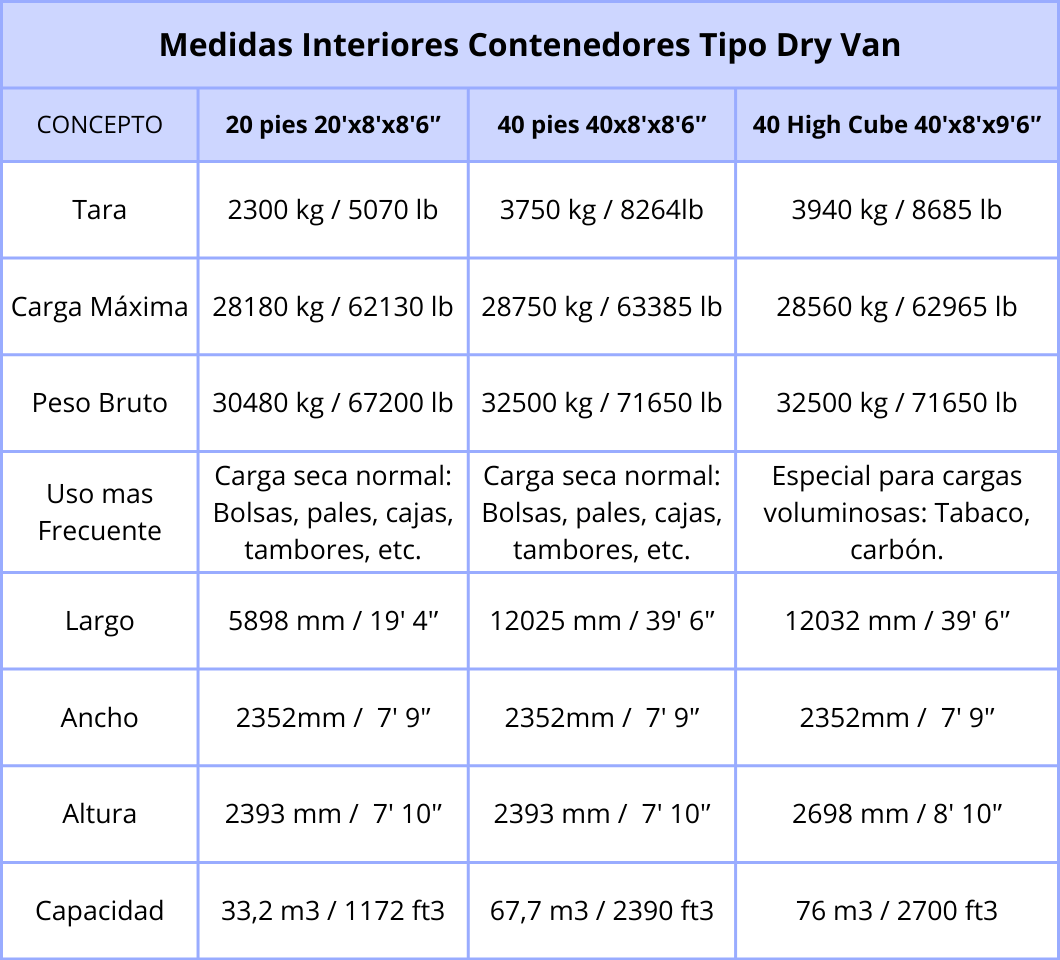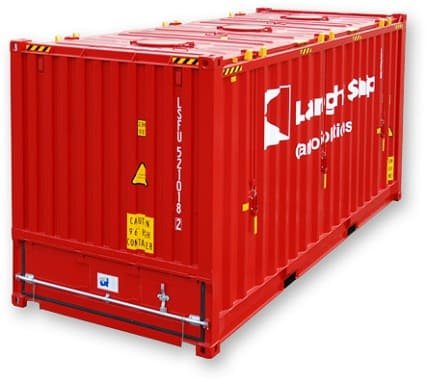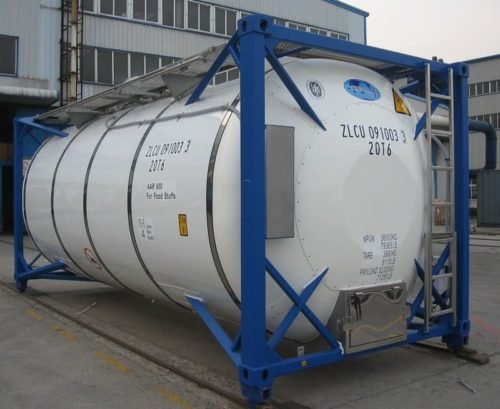Container dimensions vary based on type and intended use. By understanding these dimensions, you can make informed choices that cater to your specific needs. Beyond the standard 40-foot container, there are other options like refrigerated, open-top, platform, and tank containers. Each of these types caters to specific transportation and storage requirements. Refrigerated containers maintain controlled temperatures for sensitive goods, while open-top containers provide flexibility for larger or irregularly shaped cargo. Platform containers are ideal for heavy or bulky loads, and tank containers are used for liquids or chemicals.
Types of Containers
There are options that are longer, shorter, and taller, not to mention less common options such as:
- Refrigerated containers,
- Open-top containers,
- Flat rack containers, and
- Tank containers.
How Big Is a Container?
| Tabla | LENGTH | WIDTH | HEIGHT |
| Standart 20-foot | 19’10 1/2″ (6.06 m) | 8′ (2.44 m) | 8’6″ (2.59 m) |
| Standart 40-foot | 40′ (12.19 m) | 8′ (2.44 m) | 8’6″ (2.59 m) |
| High Cube 20-foot | 19’10 1/2″ (6.06 m) | 8′ (2.44 m) | 9’6″ (2.90 m) |
| High Cube 40-foot | 40′ (12.19 m) | 8′ (2.44 m) | 9’6″ (2.90 m) |
| Tabla | LENGTH | WIDTH | HEIGHT |
| Standart 20-foot | 19′ 4 (5.89 m) | 7′ 8 (2.34 m) | 7′ 10 (2.39 m) |
| Standart 40-foot | 39′ 5 (12.01 m) | 7′ 8 (2.34 m) | 7′ 10 (2.39 m) |
| High Cube 20-foot | 19′ 4 (5.89 m) | 7′ 8 (2.34 m) | 8′ 10 (2.69 m) |
| High Cube 40-foot | 39′ 5 (12.01 m) | 7′ 8 (2.34 m) | 8′ 10 (2.69 m) |
Dimensions of the 20-foot container
The standard 20-foot container is popular because they are the most common, easier to maneuver, and due to their size, they can be easily combined and modified to create exceptional living spaces.
We can see the size of the 20-foot container below
- External
Length: 20 ′ 0 ″ | 6.06 m
Width: 8 ′ 0 ″ | 2.44 m
Height: 8 ′ 6 ″ | 2,60 m - Internal
Length: 19 ′ 2 ″ | 5,84 m
Width: 7 ′ 8 ″ | 2,35 m
Height: 7 ′ 9 ″ | 2,39 m
Floor area: 144 square feet | 13.3 square meters
Volume: 1,169ft³ | 33.1m³ - Doors
Door opening width: 7 ′ 8 ″ | 2.34m
Door opening height: 7 ′ 5 ″ | 2.28m
Weight: 4,840 lbs | 2,200kg
- External
Advantages and Disadvantages of 20-foot Containers
20-foot containers have a distinctive advantage over 40-foot containers. They are significantly easier to transport and maneuver. If you’re considering building a container in a remote and challenging location, then the 20-foot container is probably the best choice for you.
They are also less expensive than 40-foot containers. If you have a limited budget, 20-foot containers will be a better option. However, 20-foot containers have some disadvantages.
Firstly, each container offers a space of around 144 square feet. If you need a larger space, your only option would be to combine two containers together. This is feasible but will require time, organization, and additional expenses.
Secondly, although individually cheaper than 40-foot containers, their price per square foot is actually more expensive.
If you’re considering building a large building or home, and your land has adequate access, 40-foot containers offer better value.
Dimensions of the 40-foot Container
The other common container is the 40-foot container. A 40-foot container measures 12 meters in length. They have a width of 8 feet, which is 2.4 meters. The center of the load is 48 inches, 1,200 mm.
A 20-foot container measures 6 meters and a 40-foot container measures 12 meters with the top open, for transporting goods that won’t spoil if they are uncovered.
To properly design a container home, you must truly understand the empty containers that serve as building blocks for your project.
Once you’ve seen the thoughtful design given to the containers, you’ll start to appreciate more what they can do in their ‘second life’ as part of your home.
With all this in mind, let’s explore the variety of container types, their dimensions, and their availability. Most large container homes have used these containers. They offer exceptional value for money and considerable interior space.
How Big Is a 40-foot Container
- External
Length: 40 ′ 0 ″ | 12.2m
Width: 8 ′ 0 ″ | 2.44 m
Height: 8 ′ 6 ″ | 2,60 m - Internal
Length: 39 ′ 5 ″ | 12.03m
Width: 7 ′ 8 ″ | 2,35 m
Height: 7 ′ 9 ″ | 2.39 m (7 ′ 9 ″ | 2.39 m)
Floor area: 300 sq. ft. | 28 sq. m.
Volume: 2,385ft³ | 67.5m³ - Door
Door opening width: 7 ′ 8 ″ | 2.34m
Height of door opening: 7 ′ 5 ″ | 2.28m
Weight: 8,360 lbs | 3,800kg
- External
Advantages and Disadvantages of 40-foot Containers
Due to the size of the 40-foot container, there is over 300 square feet of usable space inside. We previously showcased in ‘How much do container homes cost?’ examples of homes that have been built using just one of these 40-foot containers.
Another advantage of using 40-foot containers is that they represent greater value for money overall compared to a 20-foot container. Because they are considerably longer, you have the option to divide the container into multiple rooms, which you cannot do with the smaller 20-foot containers.
“Tested heavily” containers can hold over 60,000 pounds, so you shouldn’t worry about anything you place inside. Of course, since they are larger, fewer are usually needed, and delivering and placing them is quicker.
However, 40-foot containers are more expensive to transport, and delivering them to remote locations can be a challenge. They are also difficult to maneuver, so make sure you know exactly where you want them placed on your land before delivery.
Other Types of Containers
High Cube Containers
If you’re looking for a bit more height for your home, then a great option is a high cube container. High cube containers have the same width and length dimensions as the standard containers listed above, except they are one foot taller.
This additional height will allow you to place all your electrical wiring, water pipes, etc., near the ceiling and still maintain an eight-foot ceiling height. However, high cube containers are not as common as standard containers, so they tend to be more expensive.
Dimensions of the 20-foot High Cube Container
1. Internal
Length: 19 ′ 2 ″ | 5,84 m
Width: 7 ′ 8 ″ | 2,35 m
Height: 8 ′ 8 ″ | 2.64 m (8 ′ 8 ″ | 2.64 m)
2. Door
Door opening width: 7 ′ 8 ″ | 2.34m
Door opening height: 8 ′ 4 ″ | 2.54 m (8 ′ 4 ″ | 2.54 m)
Dimensions of the 40-foot High Cube Container
1. Internal
Length: 39 ′ 5 ″ | 12.03m
Width: 7 ′ 8 ″ | 2.35 m
Height: 8 ′ 8 ″ | 2,64 m
2. Door
Door opening width: 7 ′ 8 ″ | 2.34m
Door opening height: 8 ′ 4 ″ | 2.54 m (8 ′ 4 ″ | 2.54 m)
How Big Is an Open Top Container
Open top containers are rather self-explanatory. They’re essentially the same as the containers mentioned earlier, except they lack a roof. You can get open top containers in both the standard 20-foot or 40-foot sizes as well as in the 20-foot high cube and 40-foot high cube containers.
Open top containers are not usually used when constructing container homes because they obviously need an added roof. However, if you plan on giving your container a loft and hence need to add a higher roof than even a high cube container can provide, then consider an open top container, which could be an excellent option if you can find one.
How Big Is a 45-foot Container
The final variant of containers we’re going to discuss today is the 45-foot container, mainly used in the United States. The 45-foot container shares the same width and height dimensions as 40-foot containers, but it’s an additional five feet longer.
We would normally say if you’re not desperate for that extra room, then don’t bother searching these out. You’ll be spending a lot more money for the extra five feet of space.
Summary
I hope you now have a clearer idea of which container is best for your home and that when considering which container to select, it’s the best type you can use for your container-building project.
One of the most important points to understand is that your location greatly affects the availability of different types and sizes of containers.
We recommend checking how easily less common sizes can be obtained in your area of residence or where you plan to build before investing too much time in developing a design that might not be feasible because you’d have to pay exorbitant fees to bring in an uncommon container for your project.
Remember that manufacturers have slightly different tolerance levels, usually +/- 5mm, so be sure to contact the supplier for exact dimensions. Use the dimensions listed above as a general rule.
All containers should be made in accordance with ISO 668:2013 – Series 1 freight containers – Classification, dimensions, and ratings, so check the standards if you need classification information.
Interior Measurements of the Most Used Dry Van Containers
Download this measurement table in PDF to find out How Big Is a Container here >> container-measurements
We would love to know what type of container you have chosen to use. Please let me know in the comments section below.
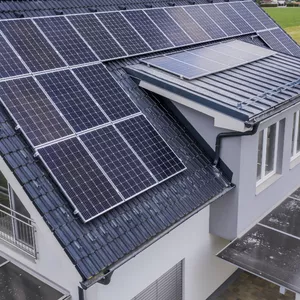 MAS INFORMACIÓN Construye Tu Casa con Contenedores Paso a Paso
MAS INFORMACIÓN Construye Tu Casa con Contenedores Paso a Paso 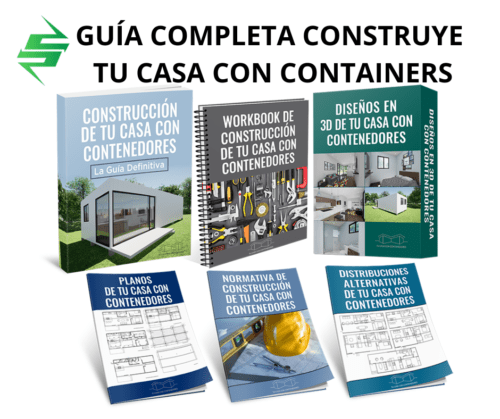 MAS INFORMACIÓNHágalo Usted Mismo Construye Tu Casa con Contenedores Paso a Paso
MAS INFORMACIÓNHágalo Usted Mismo Construye Tu Casa con Contenedores Paso a Paso


